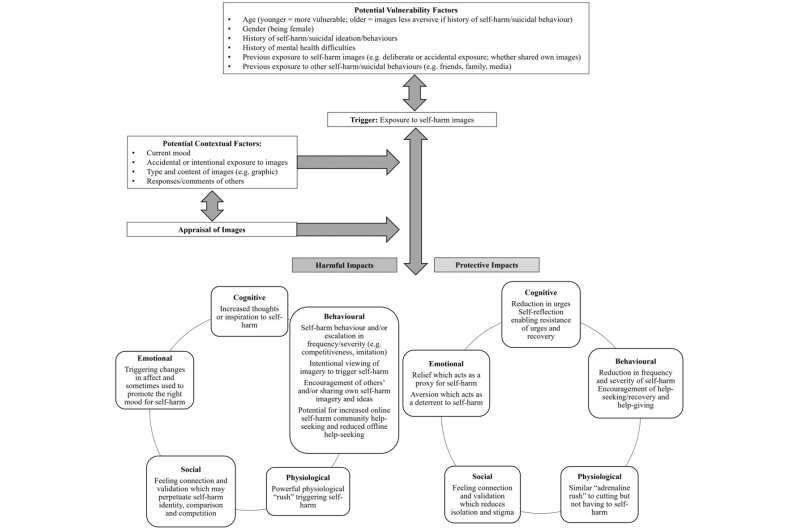Study shows viewing self-harm images online and in social media usually causes harm

Clinical researchers from Oxford University’s Department of Psychiatry and Oxford Health NHS Foundation Trust have reviewed the international research evidence regarding the impact of viewing images of self-harm on the internet and in social media. This indicates that viewing such images usually causes harm, though the findings also highlighted the complexity of the issue.
In all 15 research studies reviewed for the paper, published in the Journal of Child Psychology and Psychiatry, there was evidence that looking at images of self-harm had harmful effects. This included an increase in self-harm, such as through triggering urges to self-harm, and enabling social connections with others who are self-harming, which can reinforce an individual’s personal identity as someone who self-harms.
However, nine of the studies also indicated some ‘protective’ effects for some young people, including reduction in urges to self-harm for some, social connection with other people, and providing and receiving support.
The study follows recent cases where viewing images related to self-harm and suicide has been associated with deaths by suicide of young people, leading to calls for legislation such as through the UK’s Online Safety Bill, currently going through Parliament. But until now, there has been little research evidence in this area.
Professor Keith Hawton CBE, Professor of Psychiatry and Director of the Centre for Suicide Research at Oxford University, and a lead author on the article, said, “This review of studies from across the world, mostly on young people, provides strong support for concerns about the potential impact of viewing images of self-harm.”
“However, the mixed nature of the evidence indicates the complexity of issues regarding restrictions on online images of self-harm. While most people would agree that platforms which allow promotion of self-harm or suicide should be restricted, the situation regarding sharing of self-harm images between individuals or groups of individuals is less clear, especially as, while this can clearly be harmful, it can also be a source of support and recovery.”
“I believe that the results of our review provide evidence that is helpful for the current debate on influences of viewing images of self-harm online and in social media. This needs to be supplemented by more in-depth research.”
Dr. Anne Stewart, Consultant Child and Adolescent Psychiatrist with Oxford Health NHS Foundation Trust and another author of the review, said, “The results of this review highlight the importance for clinicians, and anyone working with young people, to be aware of the potential impact of self-harm imagery online or in social media and to check out whether the young person is accessing such material and is being harmed by it.”
Dr. Karima Susi, Clinical Psychologist, who led the review while undertaking her clinical doctorate at the Oxford Institute of Clinical Psychology Training and Research, said, “Images can trigger powerful emotions which increase the likelihood of individuals engaging in self-harm-related behaviors. Viewing images also provide a means whereby individuals can connect with one another and get support, which might not be available offline. Our findings highlight the need to address the factors that may contribute to individuals seeking support online, despite the potential for harm. The findings could be used to inform further research and widen awareness about the potentially harmful and protective effects of viewing self-harm images online.”
The team are currently conducting further research related to this issue, including an interview study of self-harm mental images in young people with a recent history of self-harm. The results of this will be available in the near future.
More information:
Karima Susi et al, Research Review: Viewing self‐harm images on the internet and social media platforms: systematic review of the impact and associated psychological mechanisms, Journal of Child Psychology and Psychiatry (2023). DOI: 10.1111/jcpp.13754
Journal information:
Journal of Child Psychology and Psychiatry
Source: Read Full Article
